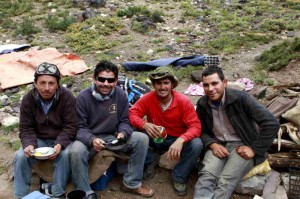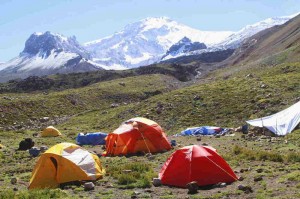UMaine Climate Change Research Team Explores Chiléan Glacier: Blog Two
Click here to see all Climate Change blog entries.
Yesterday afternoon we reached our second camp site, Agua Azul or Blue Water. To get there we hiked about six miles along the beautiful Colorado Valley. We camped on an ancient Tupungatito lava flow and had our first glimpse of our route up to the drill site for this season. Agua Azul gets its name from a nearby glacial stream which provides us with readily and easily obtainable water. At future camp sites, snow will have to be melted for drinking water. Yesterday, we gained about 3,000 feet and our current altitude is approximately 10,330 feet. We plan to stay at Aqua Azul for 3-5 days acclimatizing and preparing equipment. Our next camp site will be at roughly 13,780 feet. It is crucial that we take our time ascending the mountain, assessing each member’s health as we climb.
 We could not have gotten our supplies and equipment this far up the valley without the help of the Arrieros (Chilean cowboys) and their eight horses and 28 mules. In addition to transporting our gear, the Arrieros help us cross the Azufre River. In the past, we have been given a horse or mule with which to cross. This year, however, the water levels were low enough for us to wade or jump across. Unfortunately, despite the low river level, one of the mules slipped and fell in. The mule was completely unhurt and just got a little wet, as did our supplies. The low level of the river is likely the result of an unusually dry year. With the exception of the heavy rain that blocked one of the mountain roads at the beginning of our
We could not have gotten our supplies and equipment this far up the valley without the help of the Arrieros (Chilean cowboys) and their eight horses and 28 mules. In addition to transporting our gear, the Arrieros help us cross the Azufre River. In the past, we have been given a horse or mule with which to cross. This year, however, the water levels were low enough for us to wade or jump across. Unfortunately, despite the low river level, one of the mules slipped and fell in. The mule was completely unhurt and just got a little wet, as did our supplies. The low level of the river is likely the result of an unusually dry year. With the exception of the heavy rain that blocked one of the mountain roads at the beginning of our
expedition it has hardly rained at all this year. Earlier today the Arrieros returned to our first camp site to gather our remaining gear. It´s incredible to think that on average each of the pack animals is carrying about 100 pounds.
 A view of Tupungatito this morning revealed the slopes covered in snow. The snow may or may not remain in a day or so, but it is a reminder that we may encounter very deep snow on the glacier. Tomorrow the Arrieros will arrive with the disassembled snowmobile. If there is heavy snow on the glacier, the transportation of the snowmobile will have been well worth the effort. The snowmobile could reduce the expedition time on the glacier by 10-14 days. In the next couple of days the Arrieros will also ride up and assess the snow conditions on Tupungatito´s slopes and in the crater. The Arrieros’ horses and mules are strong enough to blaze a trail through thick snow to last year’s camp and storage site on the edge of the glacier at roughly 18,270 feet. Duing the past couple of years that we have worked with Arrieros we are continually impressed by their resourcefulness in the mountains.
A view of Tupungatito this morning revealed the slopes covered in snow. The snow may or may not remain in a day or so, but it is a reminder that we may encounter very deep snow on the glacier. Tomorrow the Arrieros will arrive with the disassembled snowmobile. If there is heavy snow on the glacier, the transportation of the snowmobile will have been well worth the effort. The snowmobile could reduce the expedition time on the glacier by 10-14 days. In the next couple of days the Arrieros will also ride up and assess the snow conditions on Tupungatito´s slopes and in the crater. The Arrieros’ horses and mules are strong enough to blaze a trail through thick snow to last year’s camp and storage site on the edge of the glacier at roughly 18,270 feet. Duing the past couple of years that we have worked with Arrieros we are continually impressed by their resourcefulness in the mountains.
The CCI component of the Tupungatito Expedition is supported by a generous gift from the Garrand Family of Portland, Maine.
